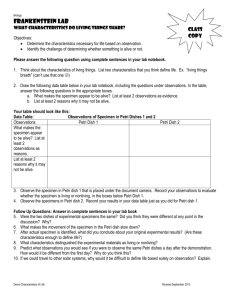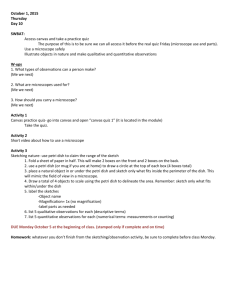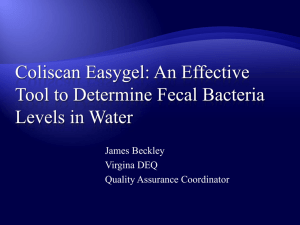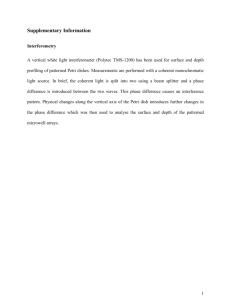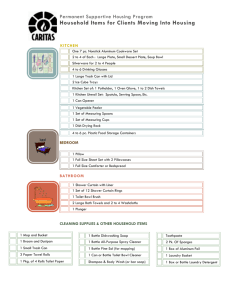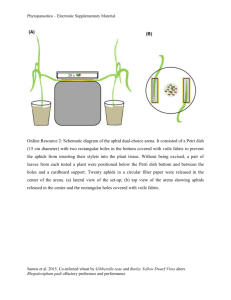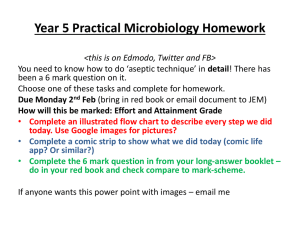obtained large
advertisement
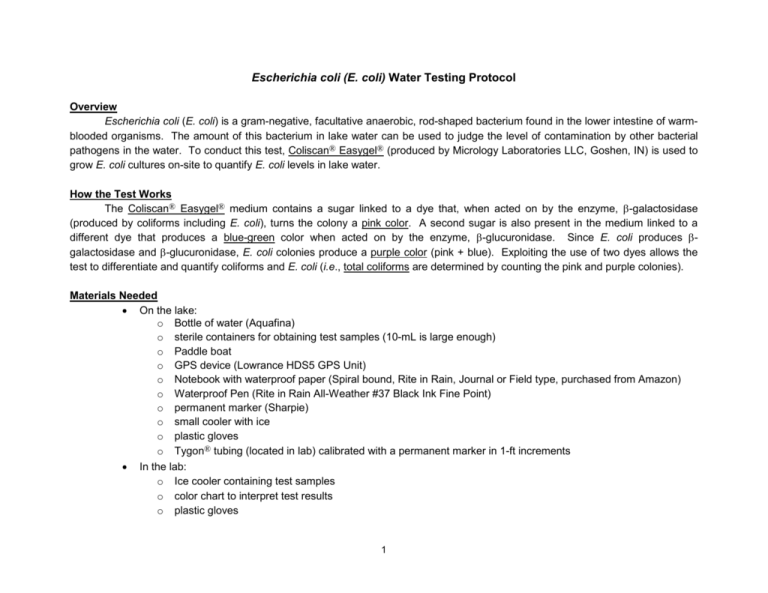
Escherichia coli (E. coli) Water Testing Protocol Overview Escherichia coli (E. coli) is a gram-negative, facultative anaerobic, rod-shaped bacterium found in the lower intestine of warmblooded organisms. The amount of this bacterium in lake water can be used to judge the level of contamination by other bacterial pathogens in the water. To conduct this test, Coliscan® Easygel® (produced by Micrology Laboratories LLC, Goshen, IN) is used to grow E. coli cultures on-site to quantify E. coli levels in lake water. How the Test Works The Coliscan® Easygel® medium contains a sugar linked to a dye that, when acted on by the enzyme, -galactosidase (produced by coliforms including E. coli), turns the colony a pink color. A second sugar is also present in the medium linked to a different dye that produces a blue-green color when acted on by the enzyme, -glucuronidase. Since E. coli produces galactosidase and -glucuronidase, E. coli colonies produce a purple color (pink + blue). Exploiting the use of two dyes allows the test to differentiate and quantify coliforms and E. coli (i.e., total coliforms are determined by counting the pink and purple colonies). Materials Needed On the lake: o Bottle of water (Aquafina) o sterile containers for obtaining test samples (10-mL is large enough) o Paddle boat o GPS device (Lowrance HDS5 GPS Unit) o Notebook with waterproof paper (Spiral bound, Rite in Rain, Journal or Field type, purchased from Amazon) o Waterproof Pen (Rite in Rain All-Weather #37 Black Ink Fine Point) o permanent marker (Sharpie) o small cooler with ice o plastic gloves o Tygon® tubing (located in lab) calibrated with a permanent marker in 1-ft increments In the lab: o Ice cooler containing test samples o color chart to interpret test results o plastic gloves 1 o o o o o o o o plastic petri dishes (obtained from Micrology Laboratories) sterile, individually wrapped pipettes (obtained from Micrology Laboratories) refrigerator bottles of Coliscan® Easygel® medium (obtained from Micrology Laboratories) incubator (oven) bleach calculator Ziploc bags large enough for disposal of used petri dishes Requirements Before Testing Incubator must be turned on and temperature set at 35° C (95° F) (set at ~4 on the knob) Keep Coliscan® Easygel® bottles in the refrigerator until use Procedure On the lake: 1. Arrive at desired site with the aid of the GPS device a. Record date, time, test site number, GPS location, water depth, and observer (who conducted the test) in your notebook b. Record number for Physical Condition (PC) of the water in your notebook: 1 = crystal clear water 2 = not quite crystal clear – a little algae/weeds visible/present 3 = definite algae/weeds – green, brown, or yellow color present 4 = high algal/weed levels with limited clarity and/or mild odor apparent 5 = very high algal/weed levels with one or more of the following present: massive floating scum/weeds/lily pads on the lake or washed up on the shoreline; strong or foul odor; or fish kill c. Water color: use your best judgment on color of water, two colors can be used to describe, light and dark as descriptors (examples include: light green, dark grey, light green/grey) 2. Put on plastic gloves 3. Label cap of bottle with the test site number. Unscrew cap of sterile container, making sure not to touch the inside of container/cap with your hands. Set upside down on a surface (smooth top side down). 2 4. Place thumb on top end of the Tygon® tubing to “seal” the tubing. Insert the tubing in the water to the 1-ft mark on the tubing. Remove thumb from top and allow the tubing to fill with water. Place thumb back on the top of the tubing and pull the tubing out of the water. 5. Aim the tube head at the open bottle, making sure not to touch the sides, take thumb off the top, and allow the water to drain from the tubing. 6. Screw top back on bottle. 7. Use bottled water (see Materials Needed) to rinse out the tubing before using it to collect the next sample. 8. If you are collecting more than one sample, store the containers in a cooler with ice to stunt growth/death rates of bacteria. In the lab: 1. 2. (see 3. 4. 5. into 6. 7. 8. 9. 10. air). 11. 12. Return to lab after collecting all samples to start Coliscan® Easygel® procedure. Put on plastic gloves. Label petri dishes with test site number, date, time, and number of mL to be used in the test below). Do not open the petri dish – write this information on the bottom of the petri dish. Open an individually-wrapped sterile pipette at the bulb end. Do not touch the end of the pipette. Shake the sterile container holding test sample for five seconds. Unscrew the cap of the sterile container holding the test sample. Squeeze the bulb of the pipette before inserting it the container. Insert the pipette into the container without touching the sides, and draw up 3-mL of water. Remove the pipette and then release bulb to avoid drawing more than 3 mL of water. Open a bottle of Coliscan® Easygel® medium. Squeeze out all water into bottle without touching the sides of the bottle or touching the tip to liquid in the Coliscan® bottle. Screw the cap on the bottle. Screw the cap onto the sterile container holding the test sample. Swirl the Coliscan® bottle slowly for five seconds to mix the sample. Do this gently to avoid the formation of bubbles in the medium. Then unscrew the cap. Open the labeled petri dish, holding its lid close over the top of the dish as possible (to avoid contamination fro the Pour the contents of the Coliscan® bottle into the petri dish, making sure to get all of the liquid transferred. Place the lid on top of the petri dish and gently swirl to evenly coat the petri dish. Place the petri dish in an incubator set at 35°C (95°F) for 24 hours. 3 13. 14. 15. After 24 hours, remove the petri dish and turn it upside down. Count the number of dark blue/ purple spots that are visible on the growth medium. Do not count pink, white, light blue, or blue-green spots. The purple dots must have a significant blue/purple tinge to them. It WILL be a noticeable difference. Use the attached Color Guide to assist in data analysis if necessary. Record the results in your notebook. To calculate the number of E. coli colonies per 100 mL of water: a. Divide 100 by the number of mL of water used in your sample (in this case, 100/3). b. Multiply the count on your plate by the result obtained from 14a. c. Record the result in your notebook as CFU/100mL. To dispose materials after testing: a. Soak the used Coliscan® Easygel® bottles in an antibacterial/water mixture with caps unscrewed overnight and dispose in the trash. b. Discard the used pipettes in the trash. c. Pour 1 teaspoon of bleach into the used petri dishes and let them stand five minutes with the tops in place. d. Place the petri dishes in a Ziploc bag, seal, and dispose in the trash. Example of Data Table Date Time 08/16/13 10:00 AM Test Site # 21 Location Observer Depth GPS coordinates Hannah Becker 5.4 ft 4 Physical Quality 3 # of spots 4 CFU/100 mL 133.33
